CRO Race Cycling Spectacle Returns in September for 6th Edition!
September 7, 2021 - The sixth edition of the international cycling race CRO Race will be held from September 28 to October 3 and will host about twenty cycling teams from Europe, Asia, America, and Australia, in six stages, on a route of more than 1,000 kilometers throughout Croatia.
The inclusion of the race in the World Cycling Organization (UCI) calendar and the 2.1 qualification rank of the race confirms the excellent status that CRO Race has in the cycling world.
"Along with top sports excitement and sound cycling names, this is a unique project that promotes Croatia in more than 190 countries around the world. Therefore, it is not surprising that the CRO Race race is called the most beautiful postcard of Croatia because during these six days we show our whole country from above and turn it into a unique sports arena," said Vladimir Miholjević, former Croatian cyclist and director of Top Sport Events, which has successfully organized all the previous five editions of the race through Croatia.
As in previous years, the race will be broadcast daily by the Croatian Radio and Television, the live broadcast will be broadcast on Eurosport, and thanks to the cooperation with the company A.S.O. it will be broadcast on six continents - in Europe, North and South America, Asia, Africa, and Australia - in as many as 190 countries.
"I thank all state institutions, counties, and cities and partners and sponsors who are just as motivated to show the world that we are ready to host the event at such a high level of competition and that we are a country striving for sporting success and can amaze the world with its natural beauty and heritage," Miholjević pointed out.
Miholjević also adds that the list of teams is impressive this year as well - the teams Jumbo Visma, Bike Exchange, Israel Start-Up Nation, and Bahrain Victorious are just some of those who announced their arrival. This is very reminiscent of previous editions of the race when we had the opportunity to see some of the biggest names in professional cycling, such as Vincenzo Nibali, Marko Cavendish, Tadej Pogačar, Primož Roglić, Adam Yates, and others.
The first stage of the race starts from Osijek, passes through Ludbreg, and ends in Varaždin. The town of Slunj opens the second stage, and then the cyclists descend to Lika-Senj County, which will, with a finish in the town of Otočac, provide a household for the first time at the end of one stage. After that, the entire caravan moves to the coast, more precisely to Primošten, from where the third stage, 167 kilometers long, will lead through Rogoznica to the finish line in Makarska. The fourth stage starts in Zadar, and through Starigrad, Paklenica continues with a dynamic ride along the Adriatic Highway, leading cyclists to the bonus goal in Senj and the goal in Crikvenica. The beginning of the fifth stage, which covers the Istria and Primorje-Gorski Kotar counties, is located in Rabac, passing through Pazin, Kastav, Viškovo, and Rijeka and ending in Opatija. The final, sixth stage, will start in Samobor, through Sveta Nedelja, Velika Gorica, Dugo Selo, and Vrbovec, and the last mountain goal of the race in Sveti Ivan Zelina, after which it will end in Zagreb.
More info can be found HERE.
To follow the latest sports news in Croatia, follow TCN's dedicated page.
To learn more about sport in Croatia, CLICK HERE.
Off-Road Cycling Route Between Vukovar and Sarengrad Presented
ZAGREB, June 21, 2020 - A 30-km-long cycling trail running through the countryside and vineyards from Vukovar to Sarengrad near Ilok was presented at the Vucedol Culture Museum, outside Vukovar, earlier this week.
The route is intended for the growing number of cycling tourists in eastern Croatia.
"The Vineyard Trail is an off-road route through the countryside and vineyards which we have designed because the road to Ilok is very busy and is not adapted for use by cycling tourists. The route goes past the Vucedol Culture Museum and many family farms," the head of the Vukovar-Srijem County Department for Tourism and Culture, Marija Budimir, said.
She said that last year the county had spent HRK 490,000 (€65,000) on the promotion of cycling tourism, of which 60% were grants from the Ministry of Tourism.
County prefect Bozo Galic said that Vukovar-Srijem County "has a lot of potential for cycling tourism and with the aid of EU funding we will build infrastructure for the development of this branch of tourism."
Public Electric Bicycle System RiCikleta Presented in Rijeka
ZAGREB, March 9, 2020 - A public electric bicycle system - RiCikleta, which allows citizens to rent 28 bicycles located at four terminals in the city, has been recently presented in Jadranski Trg Square in Rijeka.
RiCikleta is a smart electric bicycle with GPS tracking. The bikes are rented by scanning the QR code, that is, paying the rental through a QRPay code.
The first bicycles were ridden by Rijeka cyclist Vladimir Miholjević and Deputy Mayor Marko Filipović.
Renting a bike costs 10 kuna per hour and the maximum time of use is three hours. Bicycles will be available for use to persons over the age of 18 and the rental ends once the bike has been properly returned to the stand.
The total value of the project is HRK 1.3 million, most of which had come from the Rijeka city budget, while HRK 195,280 was provided by the Ministry of Tourism.
The project is about introducing the trend of micro and smart mobility in urban transport, which contributes to the development of alternative forms of sustainable mobility.
More Rijeka news can be found in the Lifestyle section.
Tourism Ministry to Support Cycling Tourism in Continental Croatia
ZAGREB, February 10 2020 - The Ministry for Tourism is inviting applications for grants until March 13 to allocate 5 million kuna in total for development of cycling tourism in continental Croatia, and eligible applicants include local government units from the 14 continental counties, the ministry has announced.
The funds are to be allocated from a programme for developing cycling tourism on the continent in 2020.
The Minister of Tourism Gari Cappelli says that increasing the tourism potential of continental Croatia contributes to a more even development of tourism in the country, and biking tourism, along with food tourism and health tourism, represents a highly attractive product.
"Those products are especially important for continental Croatia, which has all the prerequisites for stronger tourism positioning. Apart from that, biking tourism attracts visitors throughout the whole year, and it emphasises both the natural and the cultural heritage of particular destinations, promoting both sustainability and conservation, which is one of the basis for the further development of tourism in Croatia," the minister has said when grant applications were invited.
The ministry is co-funding around 90% of eligible costs for the implementation of an individual project. The minimum grant amounts to 100,000 kuna, and the maximum to 500,000 kuna.
The ministry notes that they have already co-financed the drafting of operational plans for cycling tourism in the 14 continental counties in 2017, and they point out the fact that the project has sparked considerable interest in all continental counties during the last 3 years, causing all of them to make a considerable step forward in developing that type of tourism.
More tourism news can be found in the Travel section.
Previous Life of PM Boris Johnson: Brac Cycling Tourism Promoter
July 23, 2019 - Boris Johnson, the former champion of cycling tourism on Brac, is the new British Prime Minister. What does it mean for Brac-UK cycling relations?
So there we go.
Love him or hate him the British Brexit Mad Cow Disease has delivered its verdict.
Boris Johnson is the new British Prime Minister, effective tomorrow.
There are lots of people reflecting on Boris' colourful and varied career, and we thought we would add our own tribute.
Being London Mayor or Foreign Secretary is all very well, but how about being a cycling ambassador for the island of Brac?
A role Boris played with distinction.
And Brac is open for all, with or without politics. It is just a gorgeous island for cyclists, and those without a bike.
Check out Boris on Brac in the video below.
To learn more about the island, check out the Total Croatia Brac in a Page guide.
Cycling in Croatia? Here is what you need to know.
BIKE FRIENDLY SUTIVAN FEATURING MAYOR BORIS JOHNSON from Hani Salama on Vimeo.
Baranjski Surduci – Ultimate Cyclo-Tourist Event
The dynamic Association of Baranja Recreational Cyclists organised on May 19th its first official event – the Baranjski Surduci cycling tour. The Lajmir lake near Beli Manastir was the starting point of this cyclo-tourist expedition.
The artificial lake was created in the early 20th century when it was excavated for the needs of the former Belje sugar factory, so it is understandable that its unofficial name is Sugar Lake. About twenty years ago, the sugar factory ceased its operations, so the lake has lost its original purpose. Several years ago, it was turned into a recreational and excursion area. A nearly four-kilometre-long cycling trail was built on the embankment along the Karašica river, which feeds the lake, with rest areas and a skate park.
For those who do not know, there are two Karašica rivers in Croatia. One is located in Slavonia, formed by the joining of the Vojlovica and Čađavica rivers, and enters the Drava river near Petrijevac, while the other is located in Baranja, starting at Pecsvarad in Hungary and flowing into the Danube near the Battle of Batina monument.
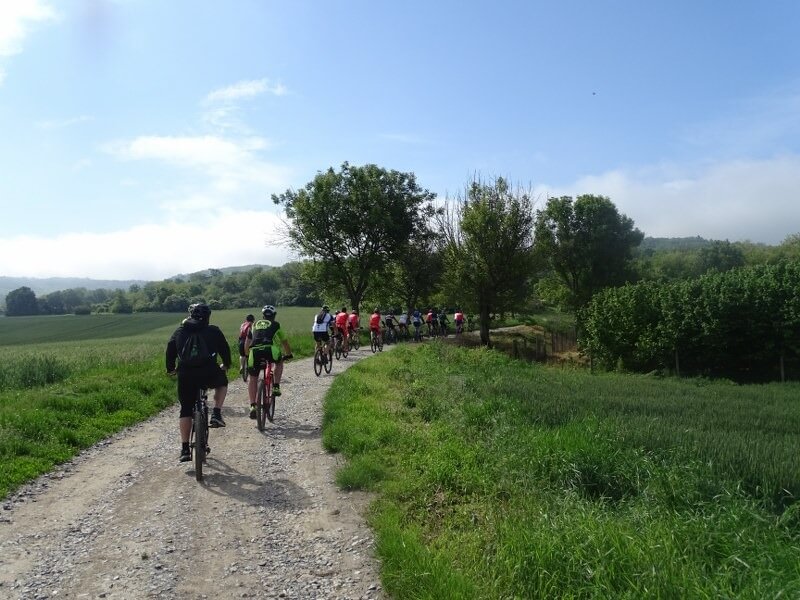
After receiving the starting packages that included a lunch voucher and a drink, a backpack, a t-shirt, a bidon, a pen and a notebook with the event logo (everything for just 60 kuna) and an obligatory group photograph, sixty brave bikers went towards Banovo Hill to get to know its natural beauties and attractions, especially the surduks.
Surduks are steep grooves on Banovo Hill, created by the descent of the rainwater from the hill. Surduks on Banovo Hill can be a few metres tall because the roots of trees on the sides prevent their collapse. When the crowns of these trees join, you are left with the impression of being in a tunnel.
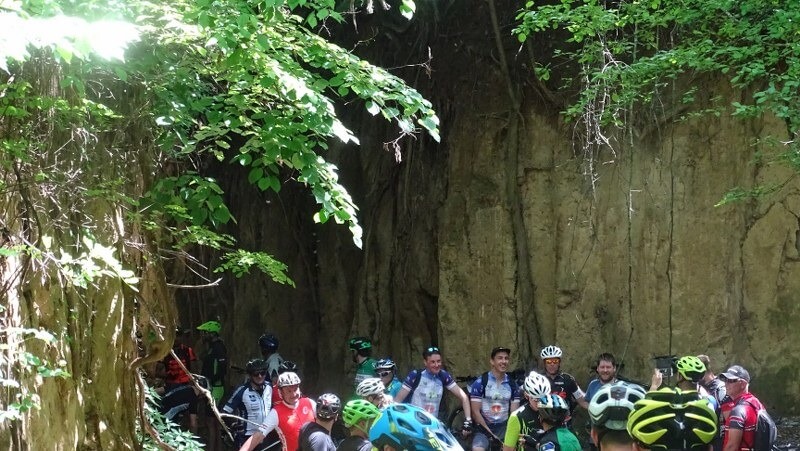
The originator of the event is Zoran Kovač from Beli Manastir, who knows surduks like his pocket, so much so that he can cycle through them in complete darkness. It is fortunate that Zoran did not keep his knowledge of surduks just for himself, but has decided to share it with others.
I thought I knew Banovo Hill well, but when I started cycling with Zoran my self-confidence when it comes to the knowledge about this Baranja hill collapsed in a very short time. Still, live and learn, and you should always spend time with people who know more than you do.
After a short ride on a bicycle trail which served to warm us up, cyclists went to Branjin Vrh, a suburb of Beli Manastir, and then towards the Baranja hill. Initially, the Hungarian name of Branjin Vrh was Baranyavar, and once this was the centre of the entire historic Baranja County. The part of Baranja which is now in Croatia is just a small part of the former Hungarian Baranja County (Baranya Varmegye), which Hungarians also call the Drava Triangle. The seat of today's Hungarian Baranja County is located in Pecs, and it stretches to the north as far as the village of Mekenyes, which is about sixty kilometres from Pecs.
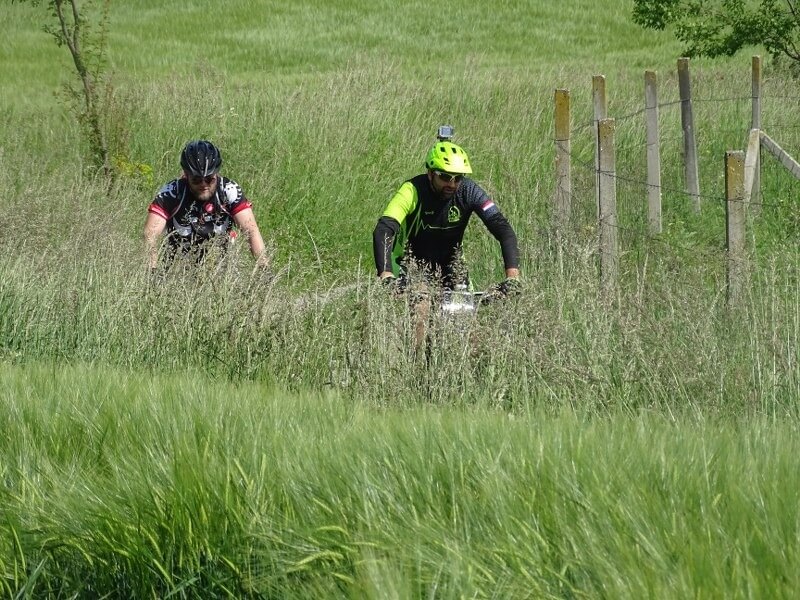
On a trail at the end of Branjin Vrh, the cyclist stopped at the cross to once again count ourselves and provide final instructions. Some prayed for good luck. The first rest point was at Popovac, at the shrine of Our Land of Lourdes, located on the other side of the hill.
In the initial phase, we partly used the multifunctional trails of the town of Beli Manastir. It is a tourist product which uses the part of Banovo Hill located within the administrative boundaries of the town of Beli Manastir as a destination for the recreation of locals and tourists. At about 50 locations on the trail, signposts have been set up, and there is also a mobile walk&bike app that contains a map of the hill, showing your location, and can be used offline.
After that, we went to the Belje wine road stretching from the Beli Manastir to the new Belje winery in Kamenac. It is asphalted and suitable for tourist buses. The central part of the wine road includes a viewpoint with a beautiful view of vast vineyards on surrounding rolling hills. We did not stay for too long on the asphalt. We turned right and rode on the grass along the edge of the vineyards, then turning into a damp, dark and muddy surduk.
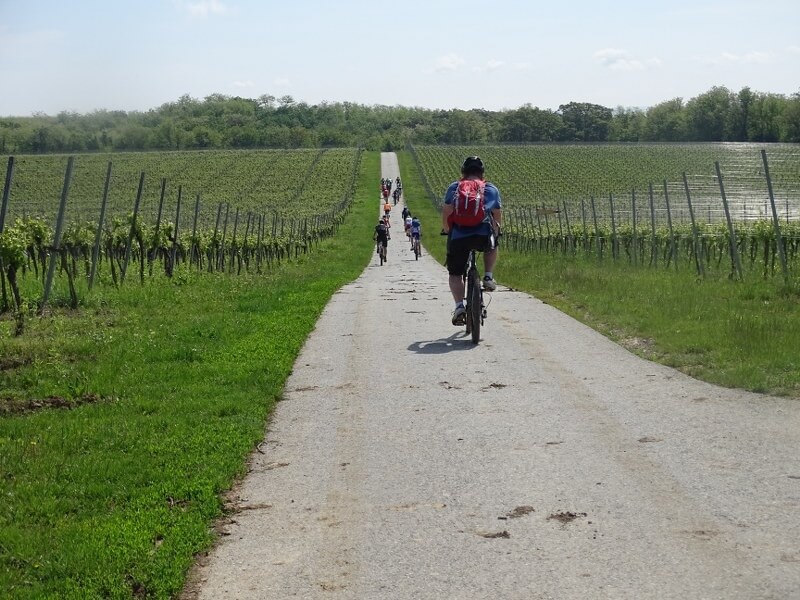
It was raining in Slavonia and Baranja for nearly the entire week ahead of the event, so many surduks were muddy, wet, especially those in the form of a tunnel, where the surrounding vegetation did not allow the sun rays to penetrate. In some places, the trail turned into a bog, so we had to ride on the thick grass next to it.
We were hoping for better terrain after leaving the surduks, but it was quite the opposite; we came across substantial muddy puddles that forced all participants to stop and lift the bicycles on their shoulders. While descending towards Popovac, we enjoyed a fantastic view of the hills in the neighbouring Hungarian Baranja, Villany-Hegyseg and its highest part called Szarsomlyo.
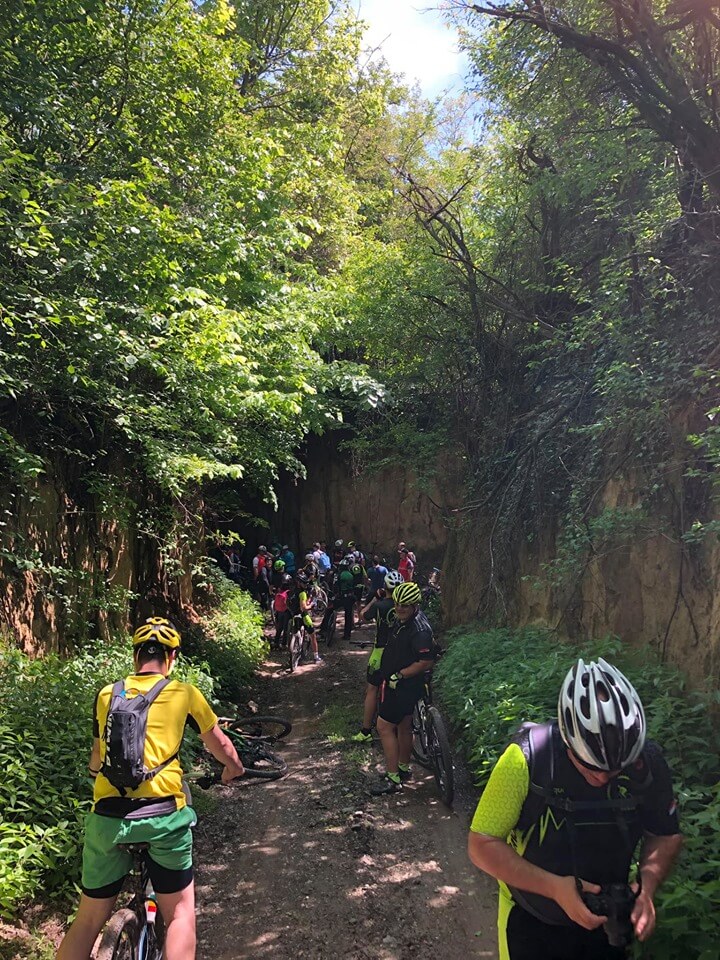
A well-deserved rest in Popovac, with water, juices, bananas, cakes, crescent rolls, and local cured meat delicacies. Although it was Sunday, the mayor of Popovac municipality Zoran Kontak came to wish us luck. The original Hungarian name of Popovac is Ban, hence Banovo Hill. It received the name Popovac for its priests (pop) about a hundred years ago, after the peace treaty signed at the French castle of Trianon and the division of a once united county into the Hungarian and Croatian parts, because it is a seat of two parishes, a Catholic and an Orthodox one.
The first name of Banovo Hill was Mons Aureus, which in Latin means the golden hill. After the Eugen of Savoy expelled the Ottomans from Pannonia and Baranja joined the Habsburg Empire, the new masters called it Goldberg, which in German also means the golden hill. Goldberg is today the name for the best wine-growing site on the whole hill, with the best microclimate conditions and composition of the soil, located just above Popovac. Goldberg is also the name of the premium line of Belje wines.
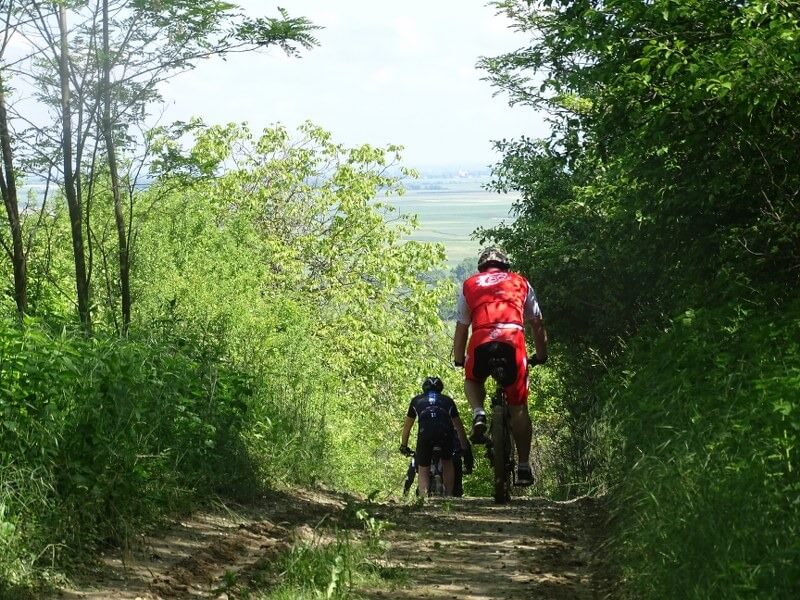
While we rested, we could see the transmitter, which was our next destination. The path to the transmitter allowed the participants to take a shorter ride on a trail that was either flat or sloping down. However, the relaxation did not last for too long, because before the transmitter it was necessary to climb again. After a short stop at the facility called Belje Villa at the foot of the transmitter, waiting to all the participants to gather, we continued the odyssey and hit the concrete path leading to the new Belje winery in Kamenac, but then turned sharply to the left and after an impressive ride ended up at the very tip of the Baranja hill, which is called Kamenjak. After that, we continued through the vast vineyards which were later replaced by meadows. After another glorious descent where we all kept nervously pressing our brakes (smell of burnt rubber could be felt), we found ourselves again in the plains, in Podolje.
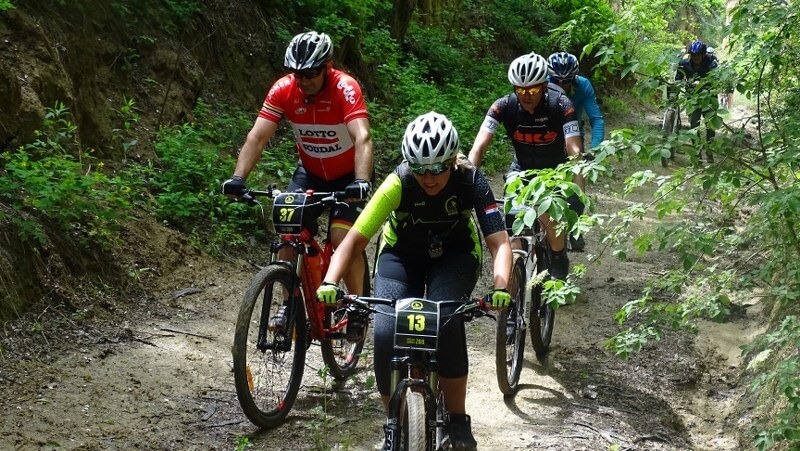
After a short rest on the asphalt road, we turned left following brown signage saying “Banska Kosa Wine Road”, and continued as before: climbing, avoiding the mud, meadows, vineyards ... Then we stopped in a gigantic surduk so that we could all gather, refresh, and immortalise the moment with a photo. This was a culmination of the bike ride. All the surduks we passed through were "dwarves" compared to this one. Many participants could not imagine that something like that even existed in Baranja until they came and saw it for themselves.
After a half-circle along the surduk, we were again on the same asphalted road, and a large herd of lambs passed us on to the left. There are three theories about how the name Baranja came about, one Slavic and two Hungarian. The first is that it comes from the word “barany”, which means lamb in Hungarian, the second is that it comes from “boranya”, which in Hungarian means the wine mother. After the vast vineyards, we finally saw the lambs, which provided us with at least one "proof" in favour of the second Hungarian theory. Slavic theory suggests that the name Baranja comes from the word “bara” (bog). Even though we were far from Kopački Rit, we saw more than enough bogs. Despite all this, I am somehow more prone to believe that Baranja is first and foremost the wine mother.
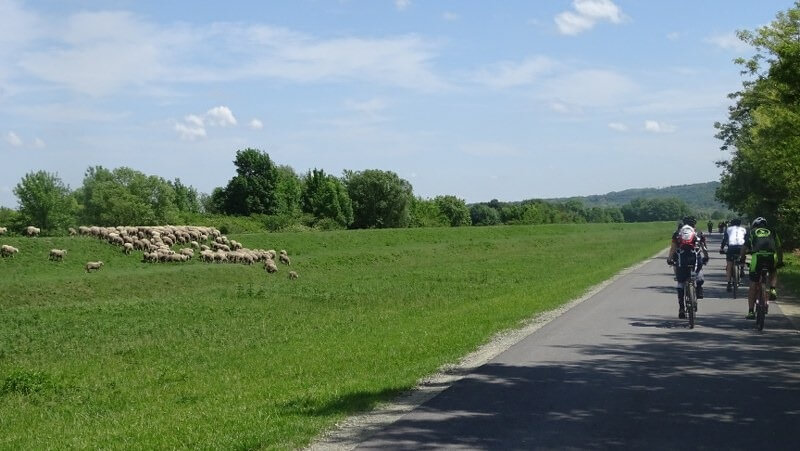
Even more surduks followed with vineyards and trails... The transmitter, as a landmark, was now on the opposite side than when we were watching it during the rest stop in Popovac. After the downhill ride, we found ourselves on the Kotlina-Podolje road, the first asphalt road that crossed Banovo Hill and the only place you have to touch the asphalt if you want to pass Banovo Hill on unpaved trails. One group went towards Kotlina on a more comfortable, asphalted road, while the second group continued on the trails, through more surduks and through the muddy loess. Where it was not wet, the ground was brittle, with clumps crushing into the dust under our tires. In Kotlina, near the pond, there was the second and final rest stop. Similarly as in Popovac, we were treated to water, a few dried fruits, banana, cookies, a piece of cheese, sausage, bacon and we were ready for new surduks.
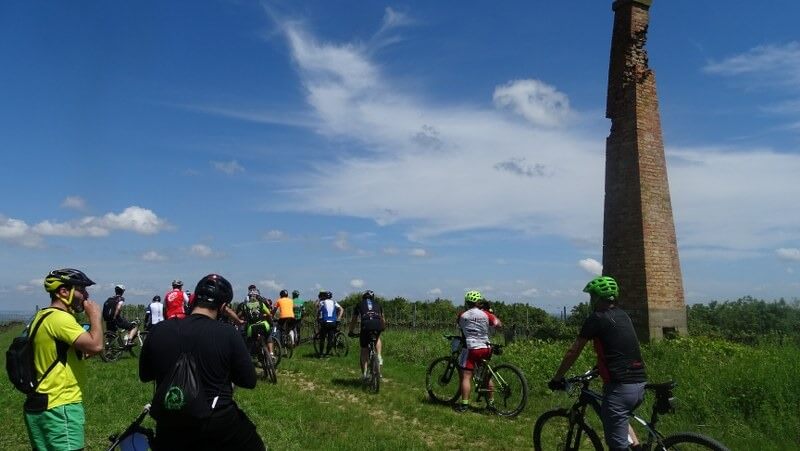
After a long and relaxing ride at the foothills, we used the last atoms of our strength to climb to the ridge of the hill, and we were rewarded with an asphalted Belje road on which we were several hours before. Driving through the winding and rolling vineyards, we came to the Belje viewpoint and continued after a short break. The culmination of this road section of the event was the crazy and unforgettable downhill ride on the Garmisch, as this part of Banovo Hill is often called.
At the beginning of the ride, I managed to get a puncture, which I realised while pushing the bicycle through a surduk. With the aid of tire sealant, I managed to solve the problem, but after two to three hours, I realized that it did not have a permanent effect, so the tire was again losing air. While descending the Garmisch, the tire was almost entirely flat, and the ride became risky. The left or right turn could get me out of balance. Did it make sense to give up at the very end, on the asphalt road?
We reached a new bike path connecting Beli Manastir with the Belje vineyards and bumped into a bicycle service station. The worker there pumped my tire (thanks, Krunoslav!) enough to be able to ride the final two or three kilometres. No surrender, let's go. We did not return to the Lajmir lake by the standard route; we entered the town, and before the underpass that leads from Beli Manastir towards Belišće we turned right and went straight to the lake where the rest of the team, which decided to shorten the bicycle route, was already waiting for us.
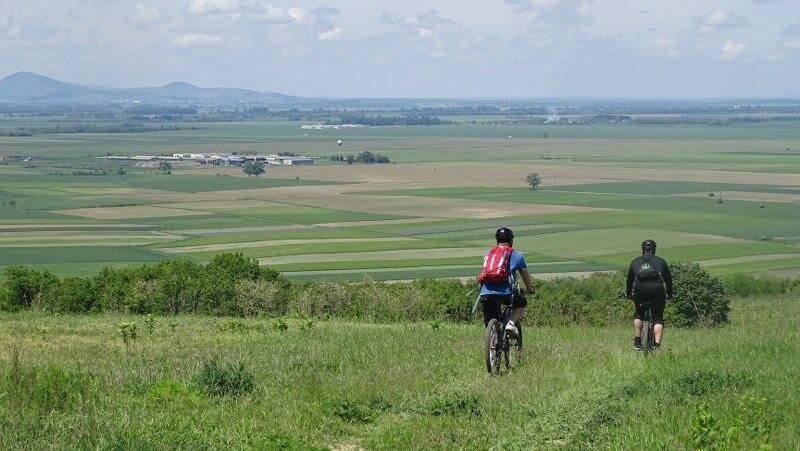
Then we were overwhelmed by a weird mixture of euphoria and fatigue, pride and exhaustion, the luck that we reached the end and the sorrow that we have left the enchanting world of the Baranja hill and its surduks and came back to the everyday life, its routine and monotony. But there will be more surduks, and this was just the beginning. We were particularly delighted by the comments of those who had been there for the first time, who said that this was fantastic and that they would visit the surduks in the future outside of organized events as well. That is the goal of this kind of events.
The Baranjski Surduci was an international event, bringing a group of cyclists from Sombor led by Robert Marton, the president of the Sombor Cycling Club, known to many cyclists as Gianni. We should also mention the oldest participant, Josip Mendelski Joka, a member of B.U.D.A. (the Donji Andrijevci Bicycle Association), who is seventy-one years old and who shamed many of much younger participants at the steepest climbs. The event also included members of the Baraber Extreme Team sports club from Belišće, the BizBike association from Bizovac, Road Team from Donji Miholjac, Kotrljaneri, Weekend Warriors and Osijek cycling club from Osijek, as well as many other unaffiliated riders.
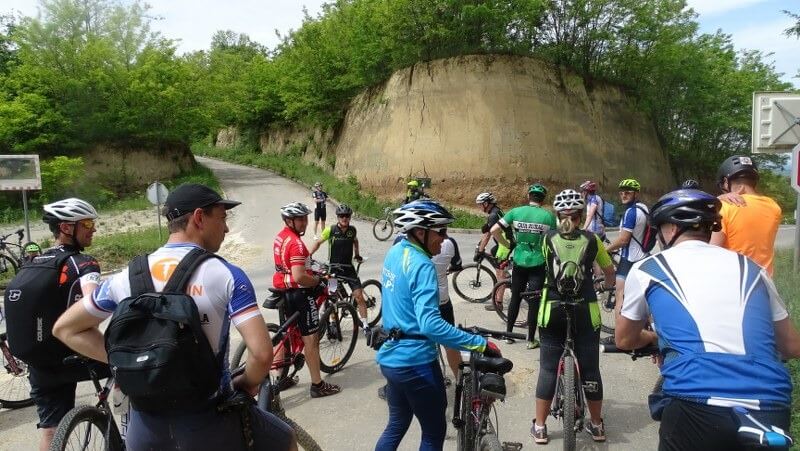
At the finish, we were welcomed by an excellent beans dish, and I do not say this just because I was starving, which is unsurprising after all the efforts made. Beans is a really interesting dish since it is more delicious if it is prepared for more people. Although this event was not a race, all participants had start numbers on bicycles. Why? We learned this only when we returned. There was a raffle organised, and fifteen lucky ones received prizes.
We should commend the association president Tanja Šoš on the organisational efforts, Zoran Kovač on the idea and leadership, and Krunoslav Perković, who took care that no one was left behind or got lost in the wilderness of the only hill in Baranja. Of course, we must not forget the volunteers from the Red Cross Society of Beli Manastir and the Oaza Peace Group NGO, and all those cyclists who enjoyed the gentle spring breeze on the paths offering fantastic views, drifted on steep and muddy surduks, cruised through endless vineyards, pushed their bicycles when the gravity did not allow them to proceed in a different manner...
Cramps and the consequent muscle inflammation, a few punctured tires, a few falls (with no serious injuries), and a bicycle failure here and there are entirely unimportant compared to all the beautiful things the participants have experienced on this event and all the memories they took with them. Or, how mountaineers and other outdoor fans love to say, "Tiredness passes, satisfaction remains”.
More cycling news can be found in the Lifestyle section.
Grgurevo Bike & Hike Coming to Požega on March 9
The old baroque town of Požega is located in the heart of Slavonia, at an altitude of 152 metres. For the last three centuries, the people of Požega have marked the anniversary of the historic date of March 12, 1688, when f. Luka Ibrišimović freed Požega from 150 years of Turkish occupation. On that day, guns and old mortars can be heard on the Sokolovac hill marking the famous battle of Sokolovac, while the town’s streets are full of historical units and town guard units from all over Croatia and abroad, with festivities continuing on the surrounding hills with a few glasses of good Požega wines. Savour the tastes of Požega with the wines and the Požega Grgurevo delicacies, and mark the battle anniversary yourselves.
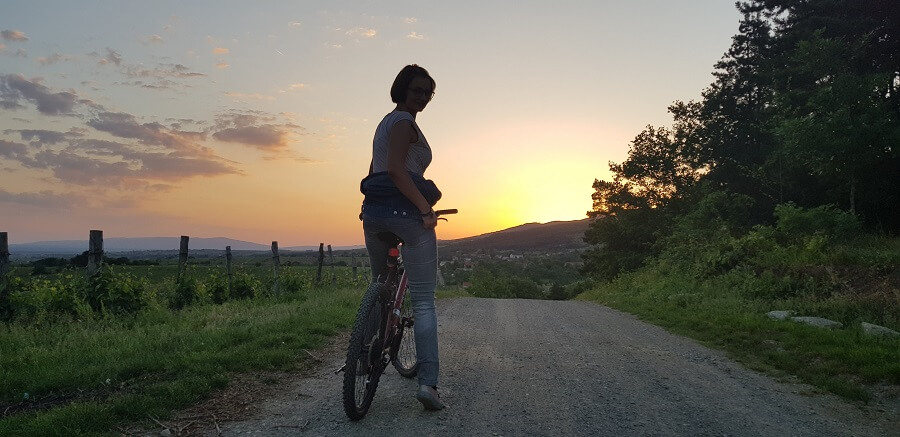
The exciting event is organised by the Luks Bike Adventure tourist agency specialising in incoming bike & wine tours. The agency has been founded and is managed by Igor Marač, who has also been overseeing the eponymous bike service shop in Požega, and who was active in sports cycling for a number of years. At the headquarters at Stjepan Radić St. in Požega, in addition to bicycles and cyclo-touristic brochures, you can also find local products from the Požega region, such as the Bridges Brewery craft beer, the Josipović sparkling wine, and homemade and handmade Luks Kuki cookies which they prepare themselves. This is an excellent starting point for getting acquainted with Požega and the Golden Valley.
Schedule
09:00-14: 00 Handicraft fair, Promenade Zone
10:00-11:30 Town tour with professional guidance
10:00-12:00 Medieval carriage ride
11:30 Review of historical troops, St. Theresa Square
11:45 "The Legend of f. Luka" play, St. Theresa Square
12:00 Hiking in Požega Hills
14:00-15:00 Riding in Požega Hills
15:00 Shooting with historical troops, in front of St. Vitus church
12:00 - START OF TOP EVENT
– a visit to the Požega vineyards, from the direction of St. Vitus Street or Holy Ghost Street (medium difficulty, 3.6 km, about an hour and a half)
– a visit of the three vineyard houses at Požega Hill
– vineyard house of the Jurković family (from 12:00)
– Čobanac strew tasting
– house wine tasting
– fruit brandy tasting
– photos next to f. Luka Ibrišimović
– festive gathering accompanied by Slavonian tamburitza music
– vineyard house of the Sajfert family (from 12:00)
– “Gojtana” with marmalade tasting
– house wine tasting
– fruit brandy tasting
– photos of the vineyard panorama and Požega in the Grgurevo frame
– shooting from the Grgurevo cannon (until 16:00)
– festive gathering accompanied by Slavonian tamburitza music
– vineyard house of the Vukušić family (from 12:00)
– tasting of Slavonian sausage and the grilled bacon
– house wine tasting
– fruit brandy tasting
– shooting from the Grgurevo cannon (until 16:00)
– festive gathering accompanied by Slavonian tamburitza music
– parlour games
– hiking in the vineyards (medium difficulty, 3.6 km, about an hour and a half)
– the possibility of bicycle riding
– 18:00 return to the Holy Trinity Square
TOP EVENT includes
– outdoor tastings; the Požega Grgurevo menu, tour of the three vineyard houses
– Slavonian tamburitza music
– tasting of Požega wines
– tasting of Požega brandies
Price of tasting: 25,00 kuna, glass with a case, including tastings of Slavonian delicacies and Požega wines in three vineyard houses on the Požega Hill
More news about Požega can be found in the Lifestyle section.
Zagreb and Varaždin Lead the Way in International Winter Bike to Work Day
ZAGREB, February 5, 2019 - Zagreb is the third and Varaždin the fourth city in the world in terms of citizens who have committed to participate in this year's International Winter Bike to Work Day on February 8, the Croatian Cyclists' Union said on Tuesday.
International Winter Bike to Work Day was launched in Canada in 2013 as a friendly competition between cities and countries around the world. It takes place annually on the second Friday in February, the Union said.
Zagreb won the competition for three years in a row thanks to those who committed to cycling to work that day at least. Novi Sad, Serbia won last year's competition.
"Currently we are in third place and Varaždin is just behind," the Cyclists' Union said, adding that the people of the two cities did not need a special day to cycle to work, even in winter.
The Union invited citizens from all over Croatia to register at www.winterbiketoworkday.org and show that there are many who cycle irrespective of the weather.
This year the weather is extremely favourable, unlike the below zero temperatures in recent years, the Union said, adding that it would offer a cyclist's breakfast at a secret Zagreb location on Friday "as an incentive and a thank-you to those who leave cars at home, thus reducing the insufferable traffic jams and air pollution."
More news on cycling in Croatia can be found in the Lifestyle section.
With 14 New Trails, Krka National Park Becomes a Cycling Heaven
Blogger Dražen Breitenfeld decided to try out some of the 500 kilometres of new bike trails in the Krka National Park. To begin with, he chose a visit to the Rogovo viewing point and came to the new Visitor Centre in Laškovica, which is the starting point for cycling through the most beautiful parts of Krka, reports tportal.hr on February 3, 2019.
The Krka national park offers fourteen cycling routes, from mountainous to relatively easy trekking routes, which will undoubtedly be exciting and highly-visited since even beginners will be able to master them.
In addition to Laškovica, the bike routes start from Skradin and the Eco campus in Puljani. These locations also have national park facilities where you can get all the information about routes, bike maps and everything else you need for a perfect getaway. Although it is still winter, when the weather is beautiful and sunny it is possible to enjoy a comfortable ride and the spectacular views of the Krka River and Miljevac plateau.
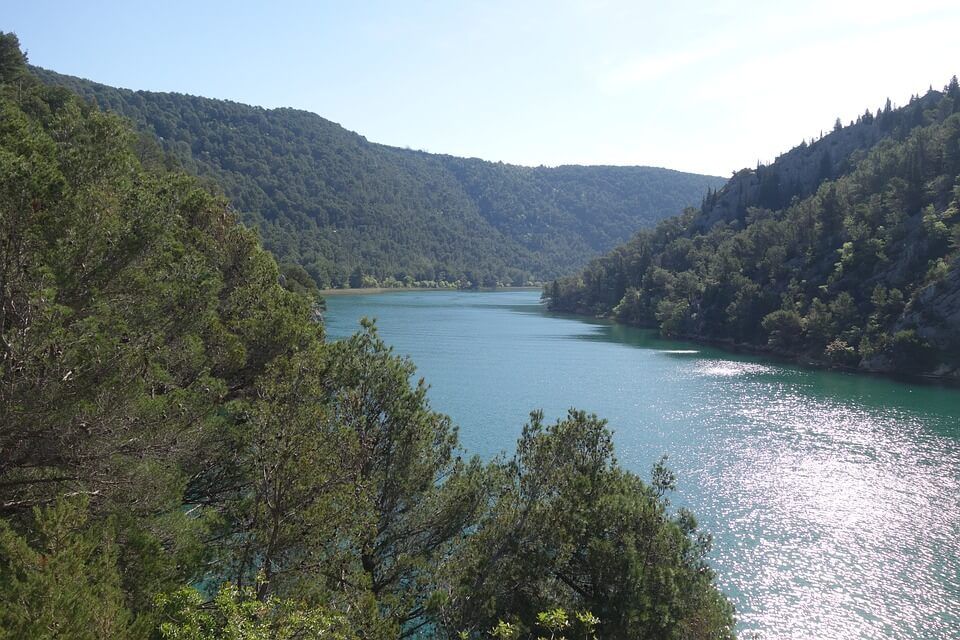
Laškovica can be reached easily and quickly from the A1 motorway, from the Skradin exit. Then you should continue to Plastovo and towards the Roški waterfall. After half an hour of driving, you will arrive in Laškovica. There is a large car park where you can leave your car and prepare for a bicycle ride, as well as a smart bench, an electric car charging station, and a nice bar where you can drink coffee, water or beverages. The trails are well-marked with blue markings and, apart from the number of the route, include the location which you are approaching, which is good for easier orientation, so you do not have to take out your map all the time.
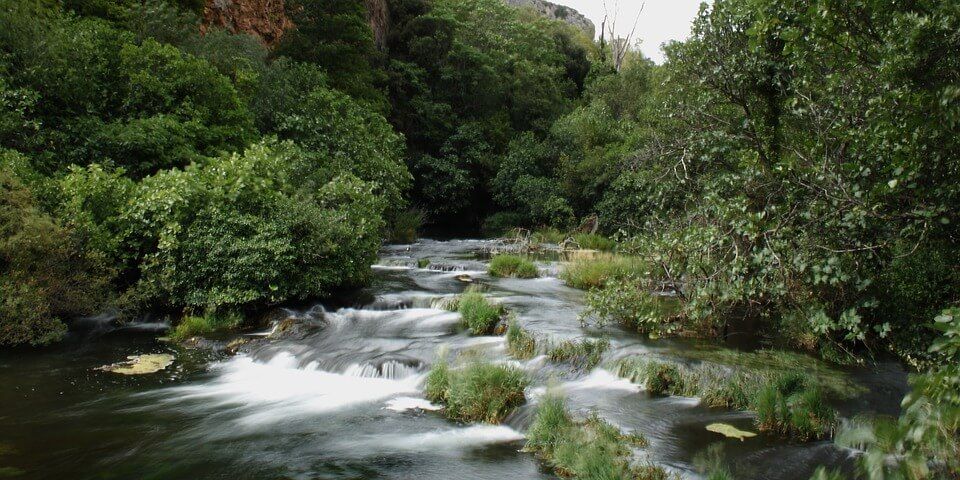
The map should nevertheless be taken at the starting point when you pay for a ticket to enter the Krka National Park. You have to buy just a regular ticket for tourists, which is cheaper outside of the primary tourist season. It now costs 30 kuna; in pre-season it is 65 kuna, while in July and August you will have to pay 110 kuna.
The Trek 5 route from Laškovica to Rogovo and Dračevica is just fourteen kilometres long. You use an asphalt road from Laškovica towards the village of Rupa, but before the village, you turn left. The trail then follows a macadam path. A half hour ride later and on your left, you will see a phenomenal view of Promina and Krka. Soon you will come to a location where you will temporarily leave your bike. Nearby is Rogovo, from where you can see almost half of the national park. Downstream is the Krka river which expands into a large lake, and you can also see the Visovac island. Everything is blue and green, and you will want to stay there for quite some time. There are climbs on this route, but you will hardly feel them since they are very mild.
Another feature which you have to visit is the Roški waterfall, which can be reached by bike or car. It is about three kilometres away, and it includes a climb on your way back. It will take you at least an hour to visit the waterfall. The whole route number 5 will take you more than two hours, not including a detour to the Roški waterfall.
More ambitious cyclists can opt for the MTB Route 2, which is longer and has more climbs. It is 34.4 kilometres long and has 732 meters of climbing. Longer and more difficult parts demand more time and more serious planning. You should also keep in mind that in the park you must respect the rules – from protecting the environment to taking care of other traffic participants, especially hikers. You should ride your bikes only on marked tracks or roads.
Of course, it is best to ride in sunny weather, and there is no lack of it here. The national park area has about 2,500 sunny hours a year. The park hopes that the bike routes will attract guests to visit other parts of the park towards the middle and upper reaches of Krka and move visitors away from the popular Skradinski Buk.
They also plan to construct one of the largest suspension bridges in the world that will connect the two banks of Krka. When it is built, the bridge over the Krka canyon will connect two fortresses, Trošenj and Nečven, and the broader areas of Promine and Kistanje.
Translated from tportal.hr (written by Dražen Breitenfeld).
More news on the Krka national park can be found in the Lifestyle section.
Varaždin Company Introducing Advanced Technology to Bicycle Production
The love of cycling and knowledge of CAD programming are the primary tools that Nino Dušak, the entrepreneur and owner of the HardCore Industry company, used to create a unique bicycle frame model. His project implements an innovative approach to solving the problem of constructing downhill bicycles and brings advanced aeronautical and naval technology into bicycle production, reports Poslovni.hr on January 4, 2019.
“I was involved in mountain biking and bicycle riding for 15 years. During my education, I acquired skills like 3D CAD design, which was enough to start with the modelling of the first prototype,” explains Dušak, who deals with the design and construction of composite frames for downhill bicycles. As a consumer in this segment of cycling, he recognized the drawbacks of other manufacturers, prompting him to develop an even better bike frame.
“The composite materials were interesting because of their small mass. Thanks to the further development of the materials, the current prototype frame weighs just 2,910 grams. We have managed to create a light and strong material for bicycle frames which are not affected by forces that are a problem for other manufacturers,” says Dušak.
He founded the HardCore Industry company in April last year with the aim of developing and manufacturing composite frames for mountain biking. The company is located at the Varaždin Technology Park, where Dušak and his associates are currently involved in the development and testing of bicycle frames. After the next investment round, they will place the product on the market.
One of the HardCore Industry team members is Jan Cimperman, the 13th best EU rider last year who tests the company's frames at the European and World Cup races. Part of the team is the Black Shadows Syndicate, involved in the creation of media content. “We have a lot of inquiries from distributors and end customers. HardCore Industry as a brand manufactures hand-made limited-series frames, and our goal is to reach the end user as quickly as possible," says Dušak.
The first testing took place in April this year in Sanremo, Italy, followed by Mandelieu-la Napoule in France. They also attended the world championship in Portugal. “We also went to the Downhill World Cup in Lošinj, the entire Slovenian Cup, and at the end the IXS Cup in Kranjska Gora. In February, we will go back to France and then Sanremo,” explains Dušak.
His entrepreneurial journey started in 2017 by signing up for "Start Your Own", a support programme for entrepreneurial projects in Croatia. HardCore Industry was one of the six selected projects among 432 applications, receiving financial resources and business support for project development.
“After winning the competition, I had enough funds to create the first prototype, which was the starting point for development that eventually resulted in another prototype that will be turned into a product ready for the market with the next round of investment,” says Dušak, who expects first revenue in mid-2019.
He says there are many great ideas in Croatia that have significant added value, but many of them fail due to the administrative burden. “Costs of ideas that require the development of products that generate money later are too large for individuals to finance their projects," says Dušak.
After the next round of investment and the start of production, there will be at least one more position created in the company. “Our business will be self-sustaining, and we plan to expand to other branches of mountain biking, as well as to city bikes,” concludes Nino Dušak.
More news on the Croatian entrepreneurs can be found in our Made in Croatia section.
Translated from Poslovni.hr (reported by Lucija Špiljak).


